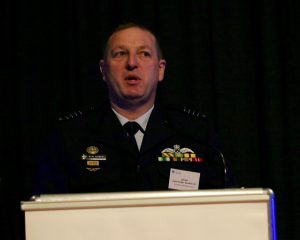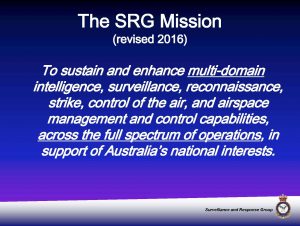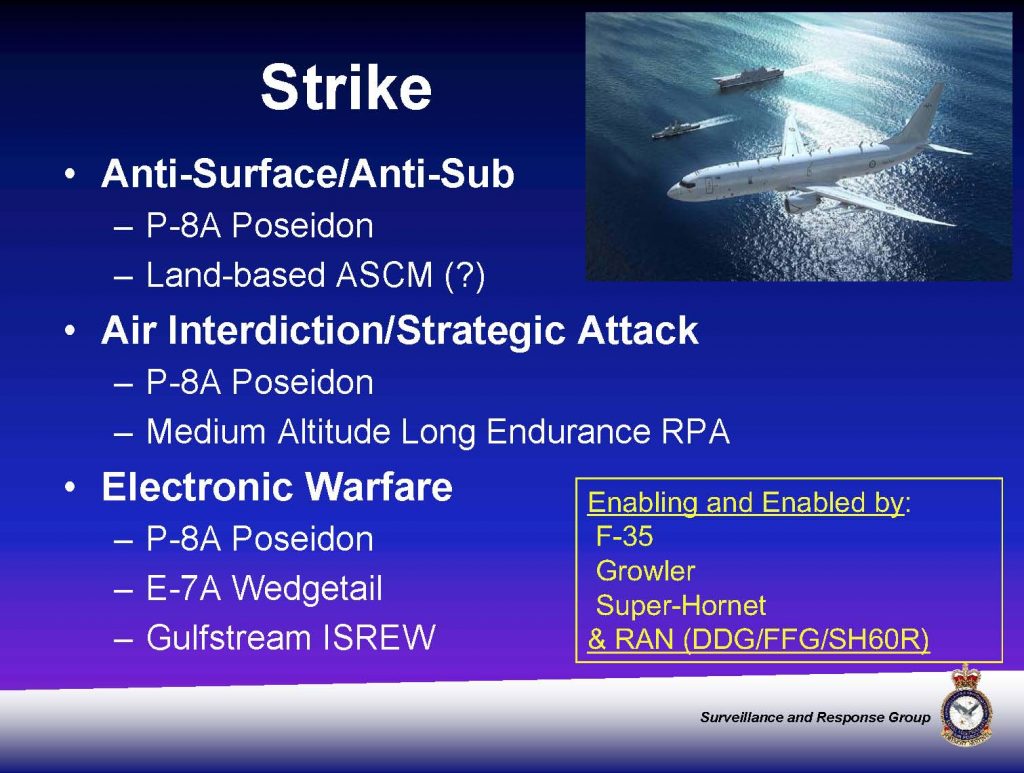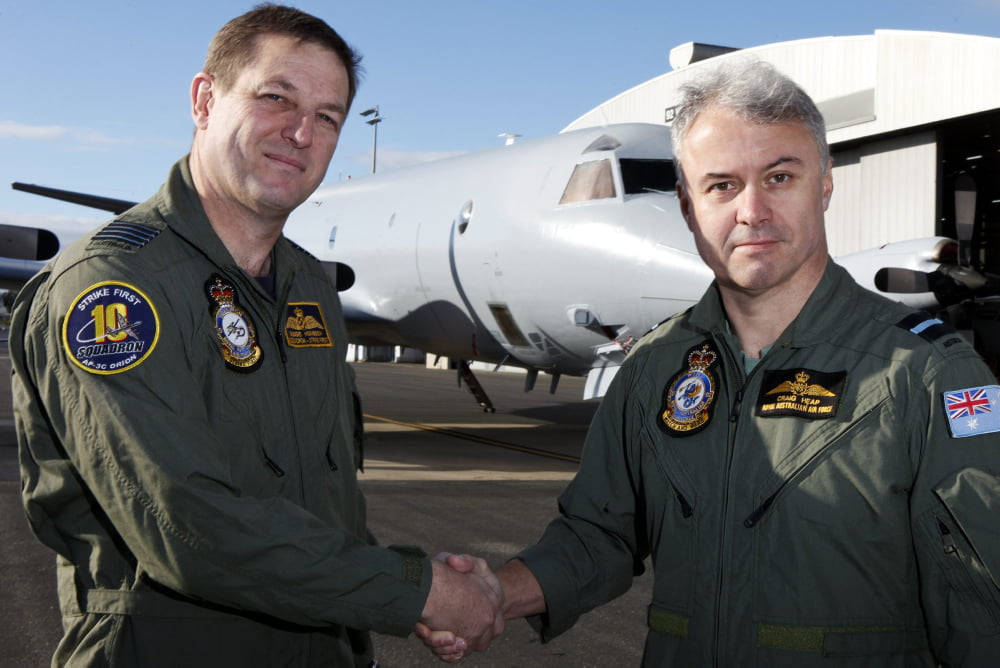2016-09-07 By Robbin Laird
At the recent Williams Foundation Air-Sea integration seminar, the sole Royal Australian Air Force presentation was given by the Chief of Staff of the Surveillance and Response Group, Captain David Hombsch.
The Commander of the SRG, Air Commodore Craig Heap was scheduled to speak so Group Captain Hombsch had the twin challenge of presenting another person’s briefing and inserting his own operational experiences throughout to explain how the SRG fit into the broader air-sea, or multi-domain integration effort.

I have visited SRG specifically a couple of times as well as visiting the Wedgetail squadron which is part of SRG twice as well.
What I have learned from my visits is that this is a dynamic part of the transformation process. As Air Marshal (retired) Geoff Brown explained when introducing the speaker, SRG was formed from merging two capabilities, namely the maritime surveillance group (P-3) with the air surveillance group which supported fighters.
This was already a step in the right direction but the transformation of technology where ISR and C2 become blended deliverables has challenged SRG to rethink how it is organized, trains and operates.
The briefing provided an overview on how this change is coming about.
In my interview earlier this year with Air Commodore Heap indicated that he was dual hatted and was heading the Jericho Maritime warfighting program, which makes SRG a key point of working the air-maritime piece for the ADF.
In that interview, he discussed the coming of P-8 and Triton specifically as new platforms, which were both redefining capabilities and part of the transformation of the approach taken by the ADF and the SRG.
He clearly was looking forward to adding the Triton to the fleet whereby the Remotely Piloted Aircraft could do wide area surveillance as an asset which could allow for better use of manned assets, or to support the initial assessment of HADR scenarios, or low intensity operations.
“What that means for our highly capable Naval surface forces is that before, where they could have an effect based principally on their organic means, which was limited by the range of their sensors and weapon systems, they now can have an effect at much greater distance, courtesy of support from a suite of state of the art RAAF assets in terms of integrated ISR, strike and C2.
As the lead for the Jericho Maritime warfighting program, we will leverage off the key Jericho tenets of maximizing combat effectiveness, facilitating innovation at the lowest level and speeding up and simplifying acquisition.
And then the question will become where is the best place to do the operational C2 in the battlespace, which will vary by mission to be on the ground, at sea or in the air, critically with full, degraded or denied enabling space capabilities such as SATCOM and GPS.
That is where we want to go with the evolving SRG,.”
Air Commodore Heap has led the process of rewriting the mission statement for SRG reflecting the integrative path on which the training, technology and operations are driving SRG as a key element in the multi-domain ISR and C2 capability of the ADF is taking it.

Group Captain Hombsch drew upon his own P-3 experience to highlight the transition. He noted that he had just returned from RIMPAC 2016, where the Aussie P-3 made its last appearance.
The P-3 has made significant contributions to Australian security, but would fly to the point of interest based on intelligence provided to it and the pick up the tracks on a platform or set of assets of interest.
With the P-8 and Triton, it was a whole new game as the planes operated in the battlespace from take off and were working from the outset with a variety of SRG and ADF assets to shape a maritime domain awareness strike capability which would become pervasive in the extended battlespace.
Indeed, one of the more interesting parts of the briefing was the discussion on strike, because classic ISR is separated from strike in terms of understanding its role, largely understood in terms of specialized platforms informing specialized strike platforms of targeting options.
With the new ISR platforms, not only did they carry strike options, but the strike platforms like F-35 were also ISR platforms which meant that a significant rethink of how to operate these platforms in an integrated manner was required.

Group Captain Hombsch underscored that Link 16 was now present on all key SRG platforms which meant that they could operate as a connected force.
Clearly, it was important not to just rely on a single network, and indeed he focused on the way ahead in shaping network redundancy and training the operators ways to operate in a multi-domain network environment, including a dark one.
Training was a key theme in which the shift from operating singular platforms supporting singular tasks to mult-tasking missions required new skill sets and new approaches to training.
He underscored that the focus was increasingly upon training operators to work in a world of integrated force TTPs.

Throughout the day, the coming of the new amphibious ships was a background theme on how a new platform could be leveraged to shape a way ahead for new approaches to force integration.
Group Captain Hombsch provided examples of how the evolution of SRG was bringing capabilities to the LHDs and, in turn, the LHDs provided a new demand signal for SRG contributions.
One example was how the Triton would provide area coverage and information for an area of interest to where the LHD and related assets would be sent on deployment. The asset could provide key information shaping the picture of the operational environment long before the ship would show up.
Put in other terms, the Triton would become a modular member of an amphibious task force.
In short, SRG is a key part of the transformation of the RAAF and the ADF overall.
Many challenges lie ahead, but the key opportunity of introducing new capabilities like P-8 and Triton and evolving the role of the Wedgetail from an air battle management system to a joint battle management system can be leveraged to shape an effective way ahead.
For earlier stories focused on the SRG, see the following:
https://sldinfo.com/visiting-williamtown-airbase-the-wedgetail-in-evolution/
https://sldinfo.com/the-raafs-surveillance-and-response-group-looks-at-the-way-ahead/
For a parallel perspective from the Royal Air Force’s ISTAR force commander, see the following interview:
Transforming the Royal Air Force’s ISTAR Force: A Discussion with Air Commodore Dean Andrew


